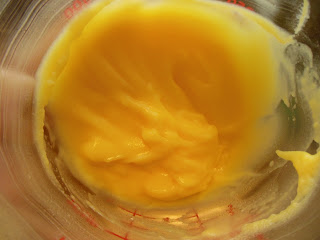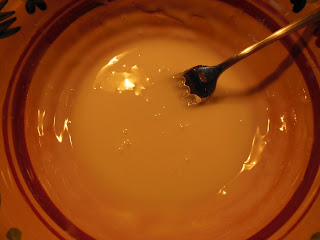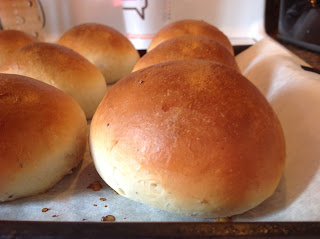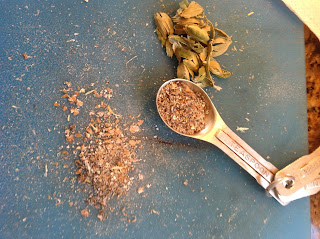When one perfect batch of Norwegian Cardamom Sweet Buns is enough to jolt you out of the boring cinnamon buns world (okay, I may have exaggerated the cardamom buns a little, it may rival the potency of a good cinnamon buns but never replace it), a good baker, read obsessive compulsive, will strive to outdo herself.
What is more perfect than to make a variation of the famous Norwegian Hveteboller?
In come Skoleboller, loose translation reads as School buns. I believe they called it school buns because all children seems to enjoy it, and the school cafeterias serve them in droves. The children became adults and they continue to eat them. Next to the regular boller at the bakery and convenience stores in Oslo, you will find the Skoleboller, which, a true fan of these babies will tell you that it is the best sweet bun ever created.
What is not to like of these vanilla custard filled buns? A pudding center with the bun surface surrounding it smeared with icing sugar and topped with a good layer of coconuts. Perfection, I am telling you. I served these to my 3-year old niece, and she proclaimed it, "Yummy!" (Apparently, that is the highest honor you will get from a toddler)
Skoleboller (Norwegian School Buns)
Ingredients
For the Buns
One batch of basic cardamom bun recipe
For the Filling
I 3.4oz box instant vanilla pudding
1 cup of cold milk
For the Toppings
2 cups of icing sugar
enough milk to make a thick spreadable icing
1 cup of coconut flakes (I prefer sweetened)
Directions
1. Prepare cardamom buns dough following the recipe here. After you have divided the dough into 12 equal portions and let it rise for another 30 mins, this is when the skoleboller process begins.
2. Prepare the vanilla pudding. In a clean bowl, combine the instant vanilla pudding powder with 1 cup of cold milk. Whisk for a min or two till filling is set. Place in the refrigerator till you are ready to use them. You can opt to make homemade vanilla pudding for this recipe.
Please remember that the pudding has to be thick, hence the reduction in milk used to the instant pudding powder ratio above.
3. Preheat the oven to 375F. Using your thumb or the back of a soup spoon, make an indentation on the buns, deep enough to hold at least 1 tablespoon of custard filling. Make a bigger well if you really like vanilla custard with buns.
4. Spoon the vanilla custard into the indentation you have made.
5. Brush the surface of the buns with milk. Bake for 15-20 minutes till bread is golden brown but before the vanilla custard is browned. Remove from the oven and let it cool completely on a wire rack.
6. In a bowl, combine icing sugar and milk to make a thick, spreadable sugar topping. Remember, you want it to look white and thick.
7. In a separate bowl or plate, place about 1 cup of coconut flakes. Dip the surface of the bun onto the coconut flakes and press down lightly to get a good coating of coconut on the bun.
8. Voila, you have just make the famous Norwegian Skoleboller. Some blog sites also note that Skoleboller happens to be one of the first Norwegian food that is commonly loved by expatriate in Norway.
Note: This is not the healthiest buns in the world but a little indulgence goes a long way. For this recipe, I used a mix of white whole wheat flour and all purpose flour to make the buns to somewhat satisfy my conscience. The buns came out just as good.
What is more perfect than to make a variation of the famous Norwegian Hveteboller?
In come Skoleboller, loose translation reads as School buns. I believe they called it school buns because all children seems to enjoy it, and the school cafeterias serve them in droves. The children became adults and they continue to eat them. Next to the regular boller at the bakery and convenience stores in Oslo, you will find the Skoleboller, which, a true fan of these babies will tell you that it is the best sweet bun ever created.
What is not to like of these vanilla custard filled buns? A pudding center with the bun surface surrounding it smeared with icing sugar and topped with a good layer of coconuts. Perfection, I am telling you. I served these to my 3-year old niece, and she proclaimed it, "Yummy!" (Apparently, that is the highest honor you will get from a toddler)
Skoleboller (Norwegian School Buns)
Ingredients
For the Buns
One batch of basic cardamom bun recipe
For the Filling
I 3.4oz box instant vanilla pudding
1 cup of cold milk
For the Toppings
2 cups of icing sugar
enough milk to make a thick spreadable icing
1 cup of coconut flakes (I prefer sweetened)
Directions
1. Prepare cardamom buns dough following the recipe here. After you have divided the dough into 12 equal portions and let it rise for another 30 mins, this is when the skoleboller process begins.
2. Prepare the vanilla pudding. In a clean bowl, combine the instant vanilla pudding powder with 1 cup of cold milk. Whisk for a min or two till filling is set. Place in the refrigerator till you are ready to use them. You can opt to make homemade vanilla pudding for this recipe.
Please remember that the pudding has to be thick, hence the reduction in milk used to the instant pudding powder ratio above.
3. Preheat the oven to 375F. Using your thumb or the back of a soup spoon, make an indentation on the buns, deep enough to hold at least 1 tablespoon of custard filling. Make a bigger well if you really like vanilla custard with buns.
4. Spoon the vanilla custard into the indentation you have made.
5. Brush the surface of the buns with milk. Bake for 15-20 minutes till bread is golden brown but before the vanilla custard is browned. Remove from the oven and let it cool completely on a wire rack.
6. In a bowl, combine icing sugar and milk to make a thick, spreadable sugar topping. Remember, you want it to look white and thick.
7. In a separate bowl or plate, place about 1 cup of coconut flakes. Dip the surface of the bun onto the coconut flakes and press down lightly to get a good coating of coconut on the bun.
8. Voila, you have just make the famous Norwegian Skoleboller. Some blog sites also note that Skoleboller happens to be one of the first Norwegian food that is commonly loved by expatriate in Norway.
Note: This is not the healthiest buns in the world but a little indulgence goes a long way. For this recipe, I used a mix of white whole wheat flour and all purpose flour to make the buns to somewhat satisfy my conscience. The buns came out just as good.

























